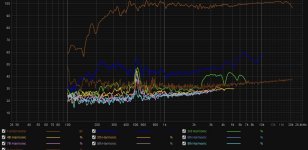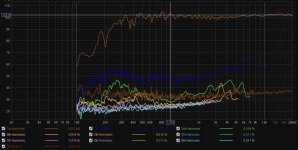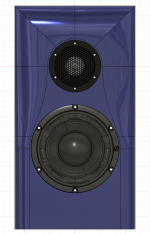team Purifi there are many midrange and midbass drivers in your range. Hope if you can come out with dedicated SUBs max duty till say 300hz. Som eof my fav drivers in Subs Peerless XLS 10 STW 350 . STW 350 is a driver that works in small boxes. very unique. Do if you have something like 8" driver would like to have a dutch & dutch type clone built . I liked buchard purifi idea of DVC purifi drivers and cardiod.
I would love to see what Purifi could come up with on the 12" and 15" woofer format for 3-ways. Is there enough "market demand" for that ?
they are certainly capable eg. co-owner Carsten Tinggaard is ex-Peerless.
With their variable coil winding it will be like TC Sounds’ Linear Motor System, with outstanding BL(x) linearity, only this time the Cms(x) linearity will be improved.
I’d like to see something that allows for a scalable solution, both from a manufacturing point of view (economies of scale, no need for retooling, lower overall cost) and a ODM’s point of view for easily upgradable designs (Multiple woofer eg. in parallel, triple or quad) leveraging the use of their amplifiers that are stable down to 1 ohm.
64Killer woofers ought to be enough for anybody…
With their variable coil winding it will be like TC Sounds’ Linear Motor System, with outstanding BL(x) linearity, only this time the Cms(x) linearity will be improved.
I’d like to see something that allows for a scalable solution, both from a manufacturing point of view (economies of scale, no need for retooling, lower overall cost) and a ODM’s point of view for easily upgradable designs (Multiple woofer eg. in parallel, triple or quad) leveraging the use of their amplifiers that are stable down to 1 ohm.
64Killer woofers ought to be enough for anybody…
team Purifi there are many midrange and midbass drivers in your range. Hope if you can come out with dedicated SUBs max duty till say 300hz. Som eof my fav drivers in Subs Peerless XLS 10 STW 350 . STW 350 is a driver that works in small boxes. very unique. Do if you have something like 8" driver would like to have a dutch & dutch type clone built . I liked buchard purifi idea of DVC purifi drivers and cardiod.
Absolutely, but PLEASE NOT BEFORE A 4" DEDICATED MID (PTT4.0M04)!
Absolutely, but PLEASE NOT BEFORE A 4" DEDICATED MID (PTT4.0M04)!
These has been quietly released to OEMs.
https://purifi-audio.com/ptt-oem/
In short- 86-87dB / 2.83V (4 ohm) drivers in fibre and aluminium cone with 3mm x-max;
I would go with retail PTT4.0X04-NAC; because although the OEM has slightly higher sensitivity, when driven to same SPL ie. 94dB it has slower distortion than the OEM version.
Note how well the metal cone resonances have been suppressed in both the retail X and OEM M
Paul is that OEM driver what you were hoping for?
I’m still looking for higher sensitivity eg >92dB/2.83V (4ohm) drivers with excellent dispersion out past 3KHz, “true midrange” flat between 250Hz-10KHz with only 1-2mm
x-max needed for acoustic LR2 HP/LP.
But it is such a niche product that there’s probably not enough demand to offer them in single runs in single retail boxes. And to avoid confusion in the retail market place.
“FAQ # 317: Which A” driver should I buy; M, W or X”
Easy, just offer the best, most versatile (X) to retail.
@lrisbo
Any plans to offer neodymium motors for higher sensitivity variants?
Last edited:
Thanks for pointing out the OEMs. The PTT4.0M04-NLC-02 sensitivity is sufficient for my goals, but I had hoped for better dispersion above 2k. At this point, I think my options are to put my T25Bs in a waveguide (which makes me very nervous) or to go with M74As or M74Bs. The M74Bs are way out of the budget.
Thanks for pointing out the OEMs. The PTT4.0M04-NLC-02 sensitivity is sufficient for my goals, but I had hoped for better dispersion above 2k. At this point, I think my options are to put my T25Bs in a waveguide (which makes me very nervous) or to go with M74As or M74Bs. The M74Bs are way out of the budget.
What makes you nervous?
Here’s one for you:
https://hificompass.com/ru/projects/horn/volnovod-dlya-tvitera-bliesma-t25b-6-t25d-6
Thanks @HiFiCompass
Heating the glue in the gap used to stick the protection grid down, then lifting it off without it pulling back into the dome from the force of the magnet, and after all that making sure nothing hits the dome without the grid. The whole process on a very expensive tweeter makes me anxious.What makes you nervous?
I can't follow all the ASR thread about the issue of March Audio Sointuva, but I wonder what is the conclusion about it. Is it a driver unit issue or Sointuva's specific issue?
Without pointing fingers at who did what, whenever one sees “distortion” in a narrow band like that, one needs to check carefully for extraneous air gaps or vibration eg. from loose/gaps between screws and surface, binding points/terminals, loose wiring.
I have measured this narrow band of “distortion” by
1) not having screws fully tightened to fasten a subwoofer to a cabinet
2) not having foam gasket behind midrange driver frame
Before:

After:

In that Sointuva sample; it was due to air leaks through binding post bolts and nuts:
https://www.audiosciencereview.com/...ements-with-klippel-device.35255/post-1229013
I have measured this narrow band of “distortion” by
1) not having screws fully tightened to fasten a subwoofer to a cabinet
2) not having foam gasket behind midrange driver frame
Before:

After:

In that Sointuva sample; it was due to air leaks through binding post bolts and nuts:
https://www.audiosciencereview.com/...ements-with-klippel-device.35255/post-1229013
Last edited:
It's mostly getting the grid off. I have essential tremor in both hands making it worse than usual. I'd also want to put some sort of grid back on the waveguide. There's no way I'd keep an expensive BE dome exposed to small curious fingers.What makes you nervous?
Here’s one for you:
https://hificompass.com/ru/projects/horn/volnovod-dlya-tvitera-bliesma-t25b-6-t25d-6
Thanks @HiFiCompass
I plan to use the PTT6.5X04, which I bought in the group buy, as the woofer and I have CSS SDX12s for subwoofers.
Strange that is the conclusion you came to. Those issues were the red herrings. Both speakers had those things in common yet only one showed the narrow band distortion. How the driver is mounted is important. Lars explained it here earlier. In a driver with more overall distortion this would go un-noticed. For clarity's sake the full extent of the problem was a narrow band distortion peak of 0.05% / -65dB relative to the fundamental and only at the specific SPL that made the mass spring oscillate. When that pokes up above an even lower distortion floor it looks bad to the eyes in a graph.In that Sointuva sample; it was due to air leaks through binding post bolts and nuts:
https://www.diyaudio.com/community/...ifi-woofer-speaker-builds.352063/post-7058058
"frame-motor resonance: this is a generic thing for all electrodynamic drivers. there is a heavy motor hanging in the frame which is bolted to a box. The frame acts as a (very stiff) spring and the motor is a mass thus forming a mass spring oscillator. All the Newton forces of the driver goes through this mass-spring system. This makes it very critical how the frame is fixed to the box since the high forces can cause rattling (ie high distortion).
It would be a lot better to mount the driver by its motor which is the source of the Newton forces but this is not standard. The best would be to bolt the motor onto a heavy solid chunk of metal serving as inertial reference to absorb the Newton forces.
Anyway, this is as mentioned a generic problem for all drivers but with the X stroke PTT drivers we have high Mms and a very strong motor in order to get low F3 in a compact box and this means the driver produces more Newtons force for the same SPL compared to a lower Mms driver. This makes the mounting method more critical including how much torque and what materials used etc.
When measuring on the driver laying on its magnet the problem is gone since the Newton forces terminate into the 'ground' and the frame is unterminated so we do not have the mass-spring oscillator."
Strange that is the conclusion you came to.
Sorry wasn’t that the big conclusion and profuse apologies to Erin from the reviewer?
Did you follow my link?
No it wasn't or shouldn't be, the apologies to Erin were due to a suggestion of collusion or covering up by not having posted a graph of the SPL level where the issue was noted. This was obviously untrue. The Purifi X drivers in quite a few measurements can be seen to have a third order distortion peak at 380Hz at certain SPL levels. This is where the basket resonance has been triggered. The mounting of the driver can damp this resonance or make it worse. The solution chosen by the owner and implemented by the reviewer was to torque the frame down and stuff the cabinet full of extra damping material. Supporting the magnet with all the stuffing had the desired effect of damping the resonance but also destroyed the tuning of the passive radiators. So I suspect they now sound worse than they did before being "fixed", but it did make the distortion graph look better.Sorry wasn’t that the big conclusion and profuse apologies to Erin from the reviewer?
The whole thing was a train wreck, I followed the thread at the time and posted in it so I am quite well aware of the sordid mess.Did you follow my link?
I got my conclusion from the apologies and correction from the reviewer:
https://www.audiosciencereview.com/...ements-with-klippel-device.35255/post-1229013
“Finally all of the improvements were done, and “Sointuva WG - DC speaker gallery version” was safely returned to the owner’s hands.
So, to summarize, there is a problem caused by internal resonance which is worsened as it leaks through the gaps. But this could be drastically improved with sophisticated sealing at the binding posts and insert nuts, and additional absorption at the inside of the enclosure.
Last mystery:
[retracted by strikethrough] Why did Erin unusually not include 86dB SPL THD data to Sointuva WG’s review?
- The End -“
To be honest I didn’t bother following the whole thing. From the start it was lost in translation…
https://www.audiosciencereview.com/...ements-with-klippel-device.35255/post-1229013
“Finally all of the improvements were done, and “Sointuva WG - DC speaker gallery version” was safely returned to the owner’s hands.
So, to summarize, there is a problem caused by internal resonance which is worsened as it leaks through the gaps. But this could be drastically improved with sophisticated sealing at the binding posts and insert nuts, and additional absorption at the inside of the enclosure.
Last mystery:
[retracted by strikethrough] Why did Erin unusually not include 86dB SPL THD data to Sointuva WG’s review?
- The End -“
To be honest I didn’t bother following the whole thing. From the start it was lost in translation…
Easy to come to the wrong conclusion when reading the headlines and not the content 😉I got my conclusion from the apologies and correction from the reviewer:
A completely incorrect assessment of what was happening. Measuring speakers properly is hard enough, interpreting the measurements and understanding what they mean is much harder.So, to summarize, there is a problem caused by internal resonance which is worsened as it leaks through the gaps. But this could be drastically improved with sophisticated sealing at the binding posts and insert nuts, and additional absorption at the inside of the enclosure.
all our motors have neodynium magnets in the pole piece in order to eliminate the FFM and inductance modulation. Changing the outer magnet to neo will only save space (which could be attractive for car use ) but not change the Bl@lrisbo
Any plans to offer neodymium motors for higher sensitivity variants?
driver mounting:
We did some experiments using a simple birch ply box:
1) screws relatively tight (1-2Nm) is best and there is only a barely detectable HD peak when sweeping at high SPL (100dB or more)
2) less tightening of the screws is just detectably worse (probably insufficient clamping force which causes micro buzzing)
3) clamping the magnet to the box via some damping putty has a beneficial effect. This is an old trick in the industry (KEF etc)
Resonances: all physical objects have resonances (eigenmodes). The question is always which modes get excited and which modes radiate sound. Moreover, a nonlinear mechanism is needed to produce distortion. Anything lose on the baffles or panels may cause distortion (xover components etc). Secure clamping of the driver frame to the box is needed to avoid buzzing.
A stand mount speaker box has its bottom to top standing wave frequency in the same frequency area as the basket/motor resonance. Any air leak can produces a distortion spike at the standing mode frequency. This is a pure air resonance n the box and the leak being nonlinear. Has nothing to do with the driver.
Again, this is all generic for all drivers as determined by the laws of physics.
The conclusion: just tighten the screws well and worry only about all the so many other important aspects of speaker box design 😀
happy building!
We did some experiments using a simple birch ply box:
1) screws relatively tight (1-2Nm) is best and there is only a barely detectable HD peak when sweeping at high SPL (100dB or more)
2) less tightening of the screws is just detectably worse (probably insufficient clamping force which causes micro buzzing)
3) clamping the magnet to the box via some damping putty has a beneficial effect. This is an old trick in the industry (KEF etc)
Resonances: all physical objects have resonances (eigenmodes). The question is always which modes get excited and which modes radiate sound. Moreover, a nonlinear mechanism is needed to produce distortion. Anything lose on the baffles or panels may cause distortion (xover components etc). Secure clamping of the driver frame to the box is needed to avoid buzzing.
A stand mount speaker box has its bottom to top standing wave frequency in the same frequency area as the basket/motor resonance. Any air leak can produces a distortion spike at the standing mode frequency. This is a pure air resonance n the box and the leak being nonlinear. Has nothing to do with the driver.
Again, this is all generic for all drivers as determined by the laws of physics.
The conclusion: just tighten the screws well and worry only about all the so many other important aspects of speaker box design 😀
happy building!
- Home
- Loudspeakers
- Multi-Way
- Exploring Purifi Woofer Speaker Builds
